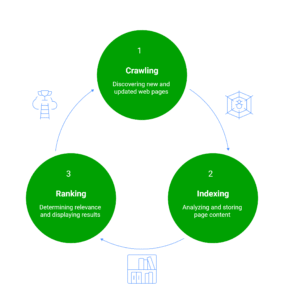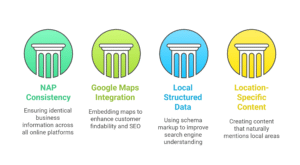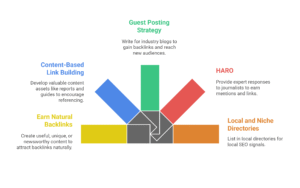Let’s get one thing straight right off the bat: just because you’re using Squarespace doesn’t mean you can ignore SEO. Sure, Squarespace handles a lot of the technical heavy lifting for you, but that’s only half the battle.
Think of it this way – Squarespace gives you a beautiful, well-built house, but you still need to put up the right address signs, make sure people can find you, and invite them in. That’s exactly what SEO does for your website.
What makes Squarespace SEO different from WordPress or other platforms? The good news is that many technical SEO headaches are handled automatically. SSL certificates, mobile responsiveness, clean code – all taken care of. The challenge? You have less granular control over certain technical elements, which means you need to be smarter about the areas you can influence.
But here’s what’s similar: content quality, keyword strategy, user experience, and building authority still matter just as much. Actually, they matter more because these are your primary levers for SEO success on Squarespace.
Effective Squarespace SEO Strategies Step by Step

1. SEO Basics for Squarespace Beginners
How Search Engines Work

Before we dive into Squarespace-specific tactics, let’s quickly cover how search engines actually work. Understanding this will make everything else click into place.
Search engines like Google have three main jobs:
Crawling: Google sends out little robots (called crawlers or spiders) to discover new web pages and updates to existing ones. They follow links from page to page, like breadcrumbs through the forest.
Indexing: Once a page is crawled, Google analyzes its content and stores it in a massive database called the index. Think of it as the world’s largest library catalog.
Ranking: When someone searches for something, Google looks through its index and decides which pages are most relevant and helpful for that query. The best matches show up first.
Here’s the key insight: Google wants to show users the most helpful, relevant, and trustworthy content for their search. Every SEO strategy should start with this simple question: “How can I make my page more helpful for people searching for this topic?”
Squarespace’s Built-in SEO Tools
One of Squarespace’s biggest advantages is that many SEO fundamentals are handled automatically. But you still need to optimize the elements you can control.
SEO Titles & Descriptions: For every page and blog post, you can set a custom SEO title and meta description. The SEO title appears in search results and browser tabs, while the meta description is the snippet of text below your title in search results.
Here’s how to set them up: Go to any page, click the gear icon, scroll down to SEO, and you’ll see fields for “SEO Title” and “SEO Description.” Your SEO title should be compelling and include your main keyword, while staying under 60 characters. Your meta description should be a clear, enticing summary under 160 characters.
URL Slugs: Squarespace automatically generates URLs based on your page titles, but you can (and should) customize them. Clean, keyword-rich URLs help both users and search engines understand what your page is about. Instead of “/my-awesome-new-blog-post-about-everything,” use “/squarespace-seo-tips.”
Technical Benefits You Get for Free: Squarespace automatically provides SSL certificates (the little lock icon in browsers), ensures your site is mobile-responsive, generates clean HTML code, and creates XML sitemaps. These are huge advantages that used to require technical expertise on other platforms.
2. On-Page SEO Best Practices for Squarespace
Step-by-Step Page Optimization
Keyword Research Made Easy: Before you optimize anything, you need to know what people are actually searching for. The good news? You don’t need expensive tools to get started.
Start with Google’s Keyword Planner (free with a Google Ads account, even if you never run ads) or Ubersuggest’s free tier. Type in topics related to your business and look for keywords with decent search volume but reasonable competition.
Here’s a simple process: List 10 topics your customers care about, plug each into a keyword tool, and look for specific phrases people search for. Instead of targeting “marketing,” you might target “email marketing for small businesses” or “social media marketing tips.”
Optimizing Headlines and Copy: Once you have your target keywords, weave them naturally into your content. Your main keyword should appear in your H1 (page title), at least one H2 subheading, and a few times throughout your content.
But here’s the crucial part: write for humans first, search engines second. Your content should read naturally and provide genuine value. If you’re forcing keywords into awkward sentences, you’re doing it wrong.
Image Optimization: Images are often overlooked, but they’re SEO goldmines. Every image on your Squarespace site should have descriptive alt text – this helps visually impaired users and gives search engines context about your images.
Before uploading images, rename the files with descriptive, keyword-rich names. Instead of “IMG_1234.jpg,” use “modern-kitchen-renovation-ideas.jpg.” Also, compress your images to keep file sizes reasonable – large images slow down your site, which hurts SEO.
Internal Linking Strategy
Building a Silo Structure: Think of your website like a well-organized filing cabinet. Related pages should link to each other, creating “topic silos” that help search engines understand your site’s structure and expertise areas.
For example, if you’re a fitness coach, you might have silos for “workout routines,” “nutrition tips,” and “weight loss advice.” Pages within each silo should link to other relevant pages in the same silo, and occasionally to related content in other silos.
Navigation and Footer Best Practices: Your main navigation should be clear and logical, using descriptive anchor text instead of generic terms like “Services” or “Stuff.” Your footer is valuable real estate for linking to important pages and including keyword-rich anchor text.
Pro tip: Create a “hub” page for each main topic area that links out to all related content. This helps search engines understand your site’s topical authority and makes it easier for users to find related information.
Mobile Optimization
Template Selection: All modern Squarespace templates are mobile-responsive, but some work better than others for SEO. Choose templates with clean designs, fast loading times, and intuitive mobile navigation.
Mobile Speed Tips: Even with a responsive template, you can improve mobile performance by optimizing images, limiting the number of widgets and plugins, and keeping your design clean and uncluttered. Test your mobile site regularly – if it takes more than 3 seconds to load, you’re losing visitors and search rankings.
Data from Google’s Web Performance Research shows that 53% of mobile users abandon sites that take longer than 3 seconds to load.
3. Technical SEO for Squarespace
Optimizing for Core Web Vitals
Core Web Vitals are Google’s way of measuring user experience, and they’re increasingly important for SEO. The three main metrics are:
Largest Contentful Paint (LCP): How quickly your main content loads (should be under 2.5 seconds)
First Input Delay (FID): How quickly your site responds to user interactions (should be under 100 milliseconds)
Cumulative Layout Shift (CLS): How much your content moves around while loading (should be under 0.1)
To test your Core Web Vitals, use Google’s PageSpeed Insights tool. Just enter your URL and you’ll get specific recommendations for improvement.
Common fixes for Squarespace sites include: optimizing images (compress them and use modern formats like WebP when possible), reducing the number of fonts and font weights you’re loading, minimizing custom code and third-party widgets, and choosing simpler page layouts for key landing pages.
Schema Markup Basics
Schema markup is code that helps search engines understand your content better. It can lead to rich snippets in search results – those enhanced listings with star ratings, prices, or other extra information.
Squarespace automatically adds some basic schema markup, but you can enhance it manually. For local businesses, add Organization schema with your name, address, and phone number. For blog posts, add Article schema with publish dates and author information.
To add custom schema, go to Settings > Advanced > Code Injection and add your structured data to the header. Google’s Structured Data Testing Tool can help you validate your markup.
Crawling and Indexation Tips
Managing Noindex Pages: Some pages shouldn’t appear in search results – like thank-you pages or private member areas. In Squarespace, you can add a noindex tag by going to the page settings, clicking SEO, and checking “Hide this page from search results.”
Canonical Tags: These tell search engines which version of a page is the “official” one when you have similar or duplicate content. Squarespace handles most canonical tag situations automatically, but be aware of them when creating similar pages or using the same content in multiple places.
4. Content Strategy That Works with Squarespace
Creating SEO-Friendly Blog Posts
Your blog is one of your most powerful SEO tools. Here’s how to make each post count:
Content Length and Structure: While there’s no magic word count, comprehensive posts (1,500+ words) tend to rank better for competitive keywords. But length alone isn’t enough – your content needs to be genuinely helpful and well-organized.
Use a clear structure with H2 and H3 headings that break up your content logically. Include bullet points, numbered lists, and plenty of white space to make your posts scannable.
Research from Backlinko’s Content Study found that the average first-page result on Google contains 1,447 words.
Keyword Placement: Include your main keyword in your post title, first paragraph, at least one subheading, and naturally throughout the content. But don’t overdo it – aim for a keyword density of 1-2%.
Multimedia Elements: Add relevant images, videos, or infographics to make your posts more engaging. Each image should have descriptive alt text and contribute to the user experience.
Blogging Schedule and Internal Linking: Consistency matters more than frequency. Whether you post weekly or monthly, stick to a schedule. And always link to other relevant posts on your site – this keeps readers engaged and helps search engines understand your content relationships.
E-E-A-T and Content Quality
E-E-A-T stands for Experience, Expertise, Authoritativeness, and Trustworthiness – Google’s framework for evaluating content quality.
Experience: Show that you have real, hands-on experience with your topic. Share specific examples, case studies, and personal insights.
Expertise: Demonstrate your knowledge through detailed, accurate information and by citing credible sources.
Authoritativeness: Build your reputation through quality content, backlinks from reputable sites, and mentions across the web.
Trustworthiness: Be transparent about who you are, provide contact information, and ensure your site is secure and professional.
Practical ways to improve E-E-A-T on your Squarespace site: Create a comprehensive About page that showcases your background and qualifications, add author bios to blog posts, include testimonials and reviews from real customers, link to credible sources when making claims, and keep your contact information visible and up-to-date.
Local SEO for Squarespace Sites

If you serve customers in specific locations, local SEO is crucial.
NAP Consistency: Your business Name, Address, and Phone number should be identical everywhere they appear online – your website, Google My Business, social media, and directory listings.
Google Maps Integration: Embed a Google Map on your contact page to make it easy for customers to find you and signal your location to search engines.
Local Structured Data: Add LocalBusiness schema markup to help search engines understand your location, hours, and services. This can help you appear in local search results and map listings.
Location-Specific Content: Create content that mentions your city, neighborhood, or service area naturally. A “Serving [Your City] and Surrounding Areas” section can help with local relevance.
5. Off-Page SEO Strategies
Building Backlinks for Squarespace

Backlinks – links from other websites to yours – remain one of the strongest ranking factors. But the focus has shifted from quantity to quality.
Earning Natural Backlinks: The best backlinks come naturally when you create content that’s genuinely useful, unique, or newsworthy. Think original research, comprehensive guides, or tools that solve real problems.
Content-Based Link Building: Create “linkable assets” – content so valuable that other sites want to reference it. This might include industry reports, ultimate guides, free tools, or compelling infographics.
Guest Posting Strategy: Writing for other blogs in your industry can earn quality backlinks and expose you to new audiences. Focus on sites that serve your target audience and accept only opportunities to write genuinely helpful content.
HARO (Help a Reporter Out): Journalists and bloggers use HARO to find expert sources for their stories. By providing thoughtful, expert responses, you can earn mentions and links in major publications.
Local and Niche Directories: For local businesses, getting listed in local directories, chamber of commerce sites, and industry-specific directories can provide valuable local SEO signals.
Social Media & Branding Signals
While social media signals aren’t direct ranking factors, they influence SEO in several ways:
Brand Awareness: Social media increases brand recognition, which can lead to more branded searches and direct traffic – both positive SEO signals.
Content Distribution: Social platforms help distribute your content to wider audiences, increasing the chances of earning natural backlinks and engagement.
Local SEO Impact: For local businesses, active social media profiles can appear in local search results and provide additional ways for customers to find and contact you.
Focus on the platforms where your audience actually spends time, and use social media to drive traffic back to your website rather than keeping all engagement on social platforms.
6. Tracking & Measuring Your SEO Success
Connecting Google Search Console and GA4
You can’t improve what you don’t measure. Setting up proper tracking is essential for SEO success.
Google Search Console Setup: In your Squarespace dashboard, go to Settings > Connected Accounts > Google. Connect your Google account and verify your site. This gives you access to crucial data about how your site appears in search results.
Key Search Console Reports:
- Performance Report: Shows which queries bring people to your site, your average position, and click-through rates
- Coverage Report: Identifies indexing issues and pages that can’t be crawled
- Core Web Vitals Report: Monitors your site’s loading speed and user experience metrics
Google Analytics 4 (GA4): Also connect GA4 through the same Connected Accounts section. GA4 shows you what people do once they reach your site – which pages they visit, how long they stay, and what actions they take.
Important Metrics to Monitor:
- Organic traffic growth over time
- Top-performing pages and blog posts
- Keywords that drive the most traffic
- Pages with high bounce rates (may need optimization)
- Conversion rates from organic traffic
Using Third-Party SEO Tools
While Google’s free tools provide essential data, paid SEO tools offer deeper insights:
SEMrush or Ahrefs Benefits:
- Keyword research with competition analysis
- Backlink monitoring and analysis
- Competitor research (see what keywords competitors rank for)
- Site audits that identify technical SEO issues
- Rank tracking for your target keywords
Free Tool Alternatives: If budget is tight, start with free versions of Ubersuggest, Answer the Public for content ideas, and Google’s own tools (Search Console, Analytics, PageSpeed Insights).
7. Common Squarespace SEO Mistakes (And How to Fix Them)
Thin Content Across Pages: Many Squarespace sites have beautiful design but skimpy content. Pages with only a few sentences rarely rank well. Each page should provide substantial value – aim for at least 300 words of useful content, even on service pages.
Fix: Expand each page with helpful details, FAQs, benefits, and relevant information your visitors actually want to know.
Duplicate Titles and Meta Descriptions: Using the same SEO title or meta description across multiple pages confuses search engines and wastes opportunities to rank for different keywords.
Fix: Write unique, descriptive titles and meta descriptions for every page. Include relevant keywords and make each one compelling enough to encourage clicks.
Unindexed Blog Posts or Archives: Sometimes blog posts or archive pages accidentally get set to “noindex,” meaning they won’t appear in search results.
Fix: Check your blog settings and individual post settings to ensure important content is set to be indexed. Only use noindex for pages you genuinely don’t want in search results.
Ignoring Image Optimization: Large, unoptimized images slow down your site and lack descriptive alt text.
Fix: Compress images before uploading, use descriptive file names, and add alt text to every image.
Poor Internal Linking: Many sites fail to link related pages together, missing opportunities to keep visitors engaged and help search engines understand site structure.
Fix: Regularly audit your content and add relevant internal links. Every blog post should link to at least 2-3 other pages on your site.
Conclusion
Remember, SEO is a marathon, not a sprint. The strategies in this guide will help you build sustainable, long-term organic traffic growth. Start implementing these tactics today, stay consistent, and watch your Squarespace site climb the search rankings.
Most importantly, never lose sight of your real goal: creating a website that genuinely helps your visitors accomplish their goals. When you focus on user value first, SEO success naturally follows.


